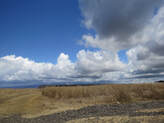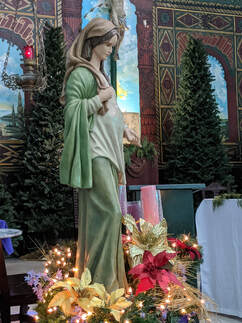 Every year I look forward to two liturgical prayers which we only have in late Advent. The first is a line in the Preface prayer said by the priest as he is preparing the bread and wine for consecration: “Mary bore Him in her womb with love beyond all telling.” The second is a set of prayers referred to as the O Antiphons, the verses proclaimed before the Gospel from December 17 through December 23, each antiphon beginning with the word, “O.” Waiting expectantly for an entire year heightens the sense of longing and desire for Jesus to return to our world anew. That these verses only come once a year, and at that, at the end of Advent, enhances the Scriptural message about the waiting world at the time of His coming 2000 years ago. The world was groaning under the labor of oppression and injustice, yet the people remained vigilant for the coming of the Messiah. The long awaited, promised Savior was indeed about to come. These two prayers, the Preface and the O Antiphons, connect us with the very same longing and waiting, aiding in expressing our desire for God, and simultaneously they give insight into this Prince of Peace and Son of Justice for whom we wait. Therefore, we are offered the opportunity to truly immerse ourselves in the mystery of God ‘bending low’ to enter into our world. Reflection upon these prayers also enables us to better recognize our own longings. For what do we long? These Advent prayers can help in both articulating our response to this question within our own hearts, and in finding what we seek within Him. In other words, if we know what we long for, we know what to seek, and thus, how to find it in the Lord. This is the beauty of Advent. 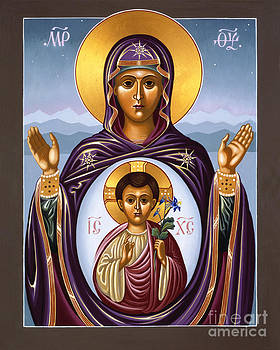 What I love about the Preface prayer for late Advent is that it expresses something so exquisitely sublime that we almost cannot fathom it. Actually, this verse was re-translated about a dozen years ago when the wording in parts of the Mass went through a few changes, so if you listen for it, – (oh, please do!) – it now reads “Mary longed for Him with love beyond all telling.” This 'new' wording focuses on something different than the version that came before it, but there is importance and deep meaning in both. The translation used presently highlights the longing of Mary for Jesus to be born. Any pregnant mother will say, especially late in the pregnancy when it is most uncomfortable, that they cannot wait for the birth, and certainly Mary's experience of riding a donkey into Bethlehem while 9 months pregnant could not have been fun. But for Mary it was more than a longing for pregnancy to end; it was her longing for a beginning, that is, for the One who was foretold, her savior and her God. Indeed, longing for God was always part of her spiritual life, heightened by His presence now within her. The other wording offers insight, too: “Mary bore Him in her womb with love beyond all telling” speaks of the depths of her motherly love for her coming Son. It directs our attention to the intimacy of the entire experience, something beyond words, beyond expression. So when we hear the line as it now reads, we can reflect upon the insights of both translations. 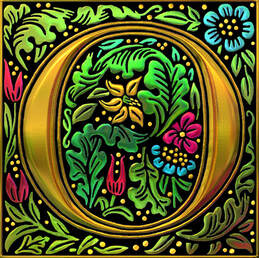 The O Antiphons are the Gospel acclamations for the days of late Advent; they are always proclaimed on the same days every year. Each of them states an aspect of who this coming Messiah is, beginning with O and His title, and ending with a plea for Him to come at last. For example, the first antiphon is “O Wisdom of our God most High, guiding creation with power and love: come to teach us the path of knowledge;” the second begins, O Leader (O Adonai), the third, O Root of Jesse, then, O Key of David (who opens the gates of Heaven), O Radiant Dawn, (sun of justice), O King of all nations, and finally, O Emmanuel (God-with-us). What is interesting is that these antiphons are also proclaimed during Evening Prayer (Vespers) as the verse before the Canticle of Mary (the Magnificat) and in that case, the wording is nuanced a little differently, because these are from the older, traditional translation of the Antiphons. Together, these two translations offer much for our reflection.* 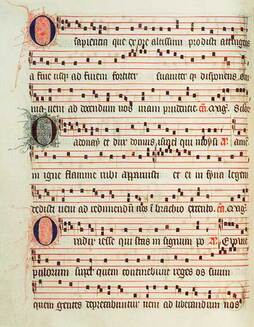 Thus, we have an invitation to ‘dive deeper’ into our Advent waiting, that is, into the Advent mysteries. If we reflect upon each Antiphon of every day from the 17th to the 23rd, we will find a wealth of insight and enter more deeply into the beauty of His coming. My suggestion is to read and then pray the translation used at Mass and also the slightly different wording prayed at Evening Prayer, letting the words resonate interiorly throughout the day. (It is attached below.) We can incorporate these Antiphons with the longing of Mary, looking to our own longing or to where we find Jesus present as Wisdom, Knowledge, the sign of God’s love for His people, the One who roots us to God’s promises to David, the One who opens Heaven, who brings light and justice into our world and the next; ultimately, our king, and our God present among us. If we add this to our Advent prayer, we surely will come away richer and we will welcome Him with deeper joy when the time of the Nativity finally arrives. Let us enter fully into the beauty of Advent! 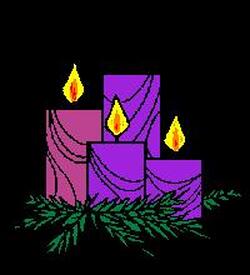 May we embrace the mysteries of late Advent with the same fervor as we began! May we look to the mysteries expressed in the liturgical prayers and antiphons! And may we find the riches and depths within our own longing that inspire us to look for the Lord in every aspect of our lives! Let us meet in our Advent longing! Peace! Maranatha! Come Lord Jesus! ©Michele L. Catanese *Both translations, the one used during Mass at the Gospel acclamation, and the traditional translation prayed at Evening Prayer, are attached below. 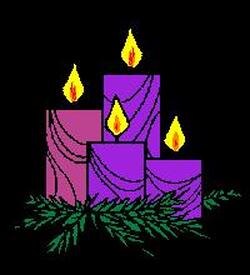 Images: 1. My photo: Statue of expectant Mary. I saw this in a church in San Juan, Puerto Rico. 2. Icon, Our Lady of the New Advent Gate of Heaven by Fr. William Hart McNichols. This icon is set in the Rocky Mountains, as it was commissioned for a church in Denver. In the hand of Jesus who is within Mary's womb, is a columbine flower. You can find this at https://fineartamerica.com/featured/our-lady-of-the-new-advent-gate-of-heaven-003-william-hart-mcnichols.html 3. Graphic print, O at beginning of an O Antiphon: reminiscent of the style of illumination as seen in the Middle Ages, particularly in music manuscript. 4. Print of Latin chant version of O Antiphons. This can be found at https://www.stgregoryoc.org/article/article-archive/the-great-o-antiphons/ 5. and 6. Clip Art of Advent candles. Since my next entry will be December 27, a Joyful Christmas to all!
Note: In compliance with GDPR rules, I wish to make it clear that I do not gather any information on any of my readers at any time.
Dwight Coles
12/14/2021 12:37:55 pm
Nice, new look at something so familiar. Comments are closed.
|
Heart Speaks to Heart
|
||||||

 RSS Feed
RSS Feed
